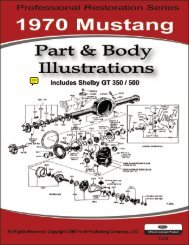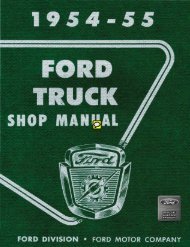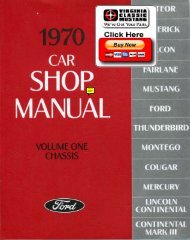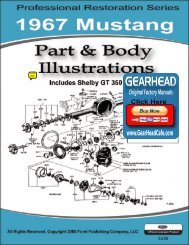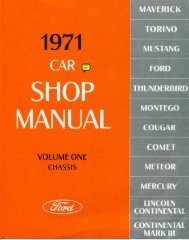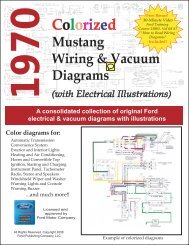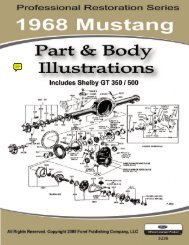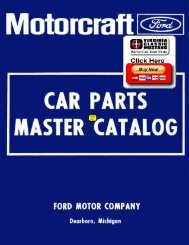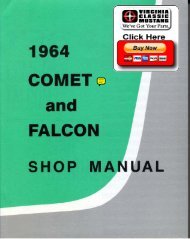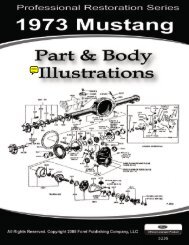DEMO - 1959 Ford Thunderbird Shop Manual - ForelPublishing.com
DEMO - 1959 Ford Thunderbird Shop Manual - ForelPublishing.com
DEMO - 1959 Ford Thunderbird Shop Manual - ForelPublishing.com
Create successful ePaper yourself
Turn your PDF publications into a flip-book with our unique Google optimized e-Paper software.
PART 1-1 -GENERAL ENGINE SERVICE 1-13<br />
1736-A<br />
FIG. 7-Valve Seat Width-Typical<br />
TO REMOVE STOCK FROM TOP<br />
OF SEAT, USE 60" WHEEL<br />
TO REMOVE STOCK FROM<br />
BOTTOM OF SEAT,<br />
USE 30* WHEEL<br />
FIG. 8 Reaming Valve Guides Typical<br />
TO REMOVE STOCK FROM<br />
BOTTOM OF EXHAUST<br />
SEAT, USE 30 WHEEL<br />
1737-A<br />
TO REMOVE STOCK FROM TOP OF<br />
INTAKE SEAT, USE<br />
15 WHEEL<br />
TO REMOVE STOCK FROM TOP OF<br />
EXHAUST SEAT, USE 60 WHEEL<br />
EXHAUST-352 AND 430 ENGINES<br />
AND INTAKE-430 ENGINE<br />
OR 60 JSt 1<br />
1738-A<br />
15<br />
1882-A FIG. 10-lntake Valve Seat Refacing-352 Engi<br />
ne<br />
FIG. 9 Valve Seat Refacing Exhaust 352 and<br />
430 and Intake 430<br />
When going from a standard size<br />
valve to an oversize valve, always<br />
use the reamers in sequence. Always<br />
reface the valve seat after the valve<br />
guide has been reamed.<br />
REFACING VALVE SEATS<br />
Refacing of the valve seats should<br />
be closely co-ordinated with the re<br />
facing of the valve face so the fin<br />
ished seat will match the valve face<br />
and be centered. This is important<br />
so that the valve and seat will have<br />
a good <strong>com</strong>pression tight fit. Be<br />
sure that the refacer grinding wheels<br />
are properly dressed.<br />
Grind the exhaust valve seats of<br />
both engines and the intake valve<br />
seats of the 430 engine to a true 45<br />
angle (Fig. 9). Grind the intake valve<br />
seat of the 352 engine to a true 30<br />
angle (Fig. 10). Remove only enough<br />
stock to clean up pits, grooves, or to<br />
correct the valve seat runout. After<br />
the seat has been refaced, measure<br />
the seat width (Fig. 7). Narrow the<br />
seat, if necessary to bring it within<br />
limits.<br />
If the valve seat width exceeds<br />
the maximum limits, remove enough<br />
stock from the top edge and/or<br />
bottom edge of the seat to reduce<br />
the width to specifications (Fig. 9<br />
or 10).<br />
On the exhaust valve seats of both<br />
engines and the intake valve seats<br />
of the 430 engine, use a<br />
30 angle<br />
grinding wheel to remove stock from<br />
the bottom of the seats (raise the<br />
seats) and use a 60 angle wheel to<br />
remove stock from the top<br />
seats (lower the seats).<br />
of the<br />
On the intake valve seats of the<br />
352 engine, use a 15 angle grinding<br />
wheel to remove stock from the top<br />
of the seats (lower the seats).<br />
The finished valve seat should<br />
contact the approximate<br />
center of<br />
the valve face. To determine where<br />
the valve seat contacts the face, coat<br />
the seat with Prussian blue, then set<br />
the valve in place. Rotate the valve<br />
with light pressure. If the blue is<br />
transferred to the center of the<br />
valve face, the contact is satisfac<br />
tory. If the blue is transferred to<br />
the top edge of the valve face,<br />
lower the valve seat. If the blue is<br />
transferred to the bottom edge of<br />
the valve face, raise the valve seat.<br />
After refacing the valve seat, it<br />
is good practice to lightly lap in the<br />
valve with a medium grade lapping<br />
<strong>com</strong>pound. Remove all the <strong>com</strong><br />
pound from the valve and seat after<br />
the lapping operation.<br />
VALVES<br />
CLEANING AND INSPECTION<br />
Remove all deposits from the<br />
valve with a fine wire brush or buff<br />
ing wheel. The critical inspection<br />
points and tolerances of the valves<br />
are illustrated in Fig. 11.




